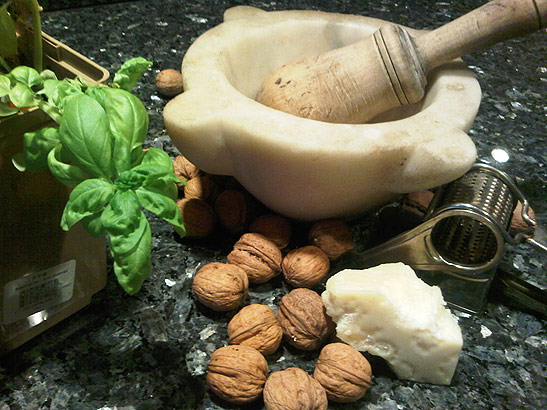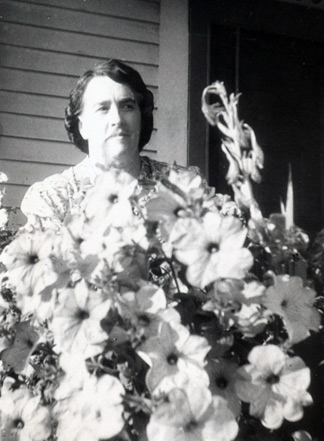 |
 |
|
 |
 |
|
|
Pesto alla Genovese By now, most of the world knows of PESTO. Though it will never be as popular as pizza, it’s a convenient and tasty sauce for a quick pasta dish, and seemingly every U.S. supermarket now has rows of Pesto in jars lining its shelves.
My connection with this simple, but delectable sauce goes back to a period pre-dating my memory. Much of my childhood was spent in the kitchen of my immigrant grandmother who hailed from Liguria, the province where Pesto originated. In her kitchen she taught me her sacred family recipes from the hills above her beloved Genoa. My love of cooking began in that kitchen and continues today. Pesto was part of this experience: she would serve it as a first-course pasta dish, generally over vermicelli. Pesto alla Genovese is quite different from what is found in the stores today. This store-bought pesto generally consists of sweet basil, pine nuts, garlic and a low quality pure olive oil, placed in a blender. Add a little Romano and Parmesan cheese and there you have it.
The real Pesto deal – according to the Boitano family – consists of placing a small portion of sweet basil, walnuts – yes, a preference for many Genovese families - garlic, extra virgin olive oil, non-salted butter, garlic, and a dash of salt and pepper –- into a mortar, where it is crushed and pounded into a paste using a pestle. Pesto in Italian means ‘pound’ or ‘pestle.’ The process is repeated a number of times. It ain’t easy. After 20-minutes, I would exclaim that this was too much work for my 12-year-old arms. My grandmother – who worked full-time as a seamstress – would laugh and say: “Work? This is fun!” Meanwhile, the vermicelli pasta – made by hand – would already be boiling in the pot. Once ready, we would drain the vermicelli, and then pour a little cold water over the pasta to stop the cooking process to keep it al dente. Pesto alla Genovese, like most Italian dishes, is served warm, not hot. We would then delicately toss the vermicelli with the Pesto, finally adding sweet cream – a surprise to many Americans – to soften the taste. An equal portion of Romano and Parmesan cheese would be added, and perhaps a dash of salt if necessary to please the palate - my grandmother never owned a single measurement utensil. Pesto is always best when served fresh, but if making a large portions it can be frozen. Just make sure you pour a layer of olive oil over the top of the jar or container. Buon appetito! This article is dedicated to the memory of Adelina Boitano Bogny: June 26, 1902 – January 11, 1997 For one cup of Pesto alla Genovese
|
Hi Audrey, Love your lamb shanks. --- Paul, Scottsdale AZ
Haven't been called Tad for . . .gee, maybe I've NEVER been called Tad . . . guess I'm the only one with chutzpah enough to mention Bourdain. BRILLIANT? --- Ken, Shutesbury, MA
I think we must have had an entirely different experience in the UK. (Fresh Food and Real Ale – week 1). We were up in Edinburgh and they served something called ‘Neeps & Tatties.’ The items were boiled so long that I couldn’t even recognize what I was eating. Come to think of it… I couldn’t taste them either. Later I found that Neeps’ are Turnips and ‘Tatties’ are potatoes. --- Lindy, Phoenix, AZ
My mouth was watering as I read some of your descriptions of the fantastic fare of ... England? I had always felt smug about the lowly reputation of British cuisine as this gave us at least one country with a worse culinary reputation than America's. I guess I'll have to change my views. Your article made me actually want to take a CULINARY tour of Britain. Yummy yummy yummy. --- Sandy Miner, Portland, OR Thanks for your note. Thanks to Traveling Boy I get to interview a world famous chef this week who is widely recognized as spearheading the Yummy movement in Ireland. Guess I'll have to take yet another culinary tour a little further north and check it out... (I love my job!) --- Audrey
Very interesting, mouth-watering piece by Audrey! (A McDreamy McMeel). Your web site is fascinating! --- Susie, Victoria, BC
Combining travel, food, and intelligent advice -- BRILLIANT! Your site fills a long-felt need for hungry roamers. Keep it up! It's Anthony Bourdain with reservations and CLASS. --- Tad, Boston, MA
|
This site is designed and maintained by WYNK Marketing. Send all technical issues to: support@wynkmarketing.com

|















